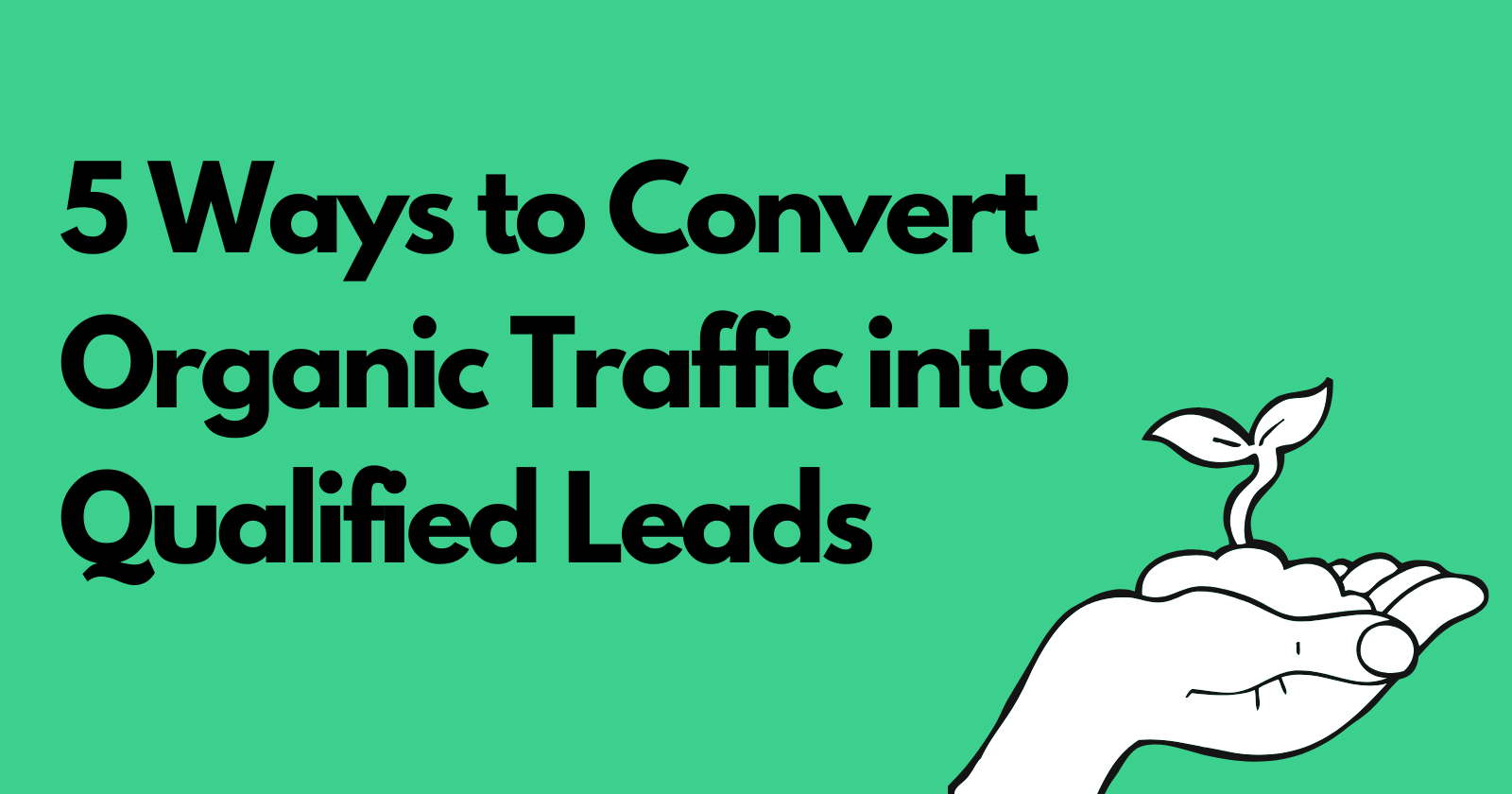So you doubled the organic traffic to your site?
Awesome! 👏👏🏽👏🏿
But also, so what?
Let me explain.
We’re all in business.
Visitors are nice, but paying customers are better.
With all the attention SEO professionals give to optimizing for search, it’s easy to neglect the other really big, important piece of the puzzle: conversion.
Don’t Hunt Without Eating
Brand awareness is golden, but only if you can translate it into actual business.
All your keyword research, site optimization, and link building efforts are a waste if they don’t result in revenue.
Getting folks onto your site is hard enough, but it’s only the beginning of the battle.
Those visitors need to convert.
And they should be converting – 16% of organic leads should turn into paying customers.
To keep your leads moving down the funnel, you need to make sure that they’re landing on the right pages, getting the content they’re looking for, and can easily buy, subscribe, request a quote, or sign up.
The good news: you have the tools in your arsenal to turn organic traffic into qualified leads.
So let’s dive into how to use them properly.
1. Match Content to User Intent
Understanding user intent is fundamental to SEO, so this isn’t necessarily a revolutionary idea.
The problem is, the concept isn’t always executed well for a number of reasons:
- Prioritizing keywords solely by volume without organizing by intent.
- Failing to communicate intent to the people developing content.
- Choosing the type of content before performing keyword research.
Improve Existing Pages
The first step to addressing issues with intent is to look at your current pages.
Some of them may have been created before you had an SEO strategy.
So there’s potential for a quick win by improving existing pages.
Also, who doesn’t love to cringe at their old content?!
Look at the queries you’re ranking for that contain transactional terms, like “buy, “pricing,” “reviews,” or “testimonials.”
- Are the pages that rank for those queries serving up content that will drive your audience to convert?
- Is the content easy to read, with easily accessible calls-to-action?
The past year, I’ve been working through a content audit I started in August for Leadfeeder’s blog.
Before I joined the team, they were working with a content marketing agency that focused solely on content creation, not driven from an SEO mindset. I identified 82 blog posts to rewrite.
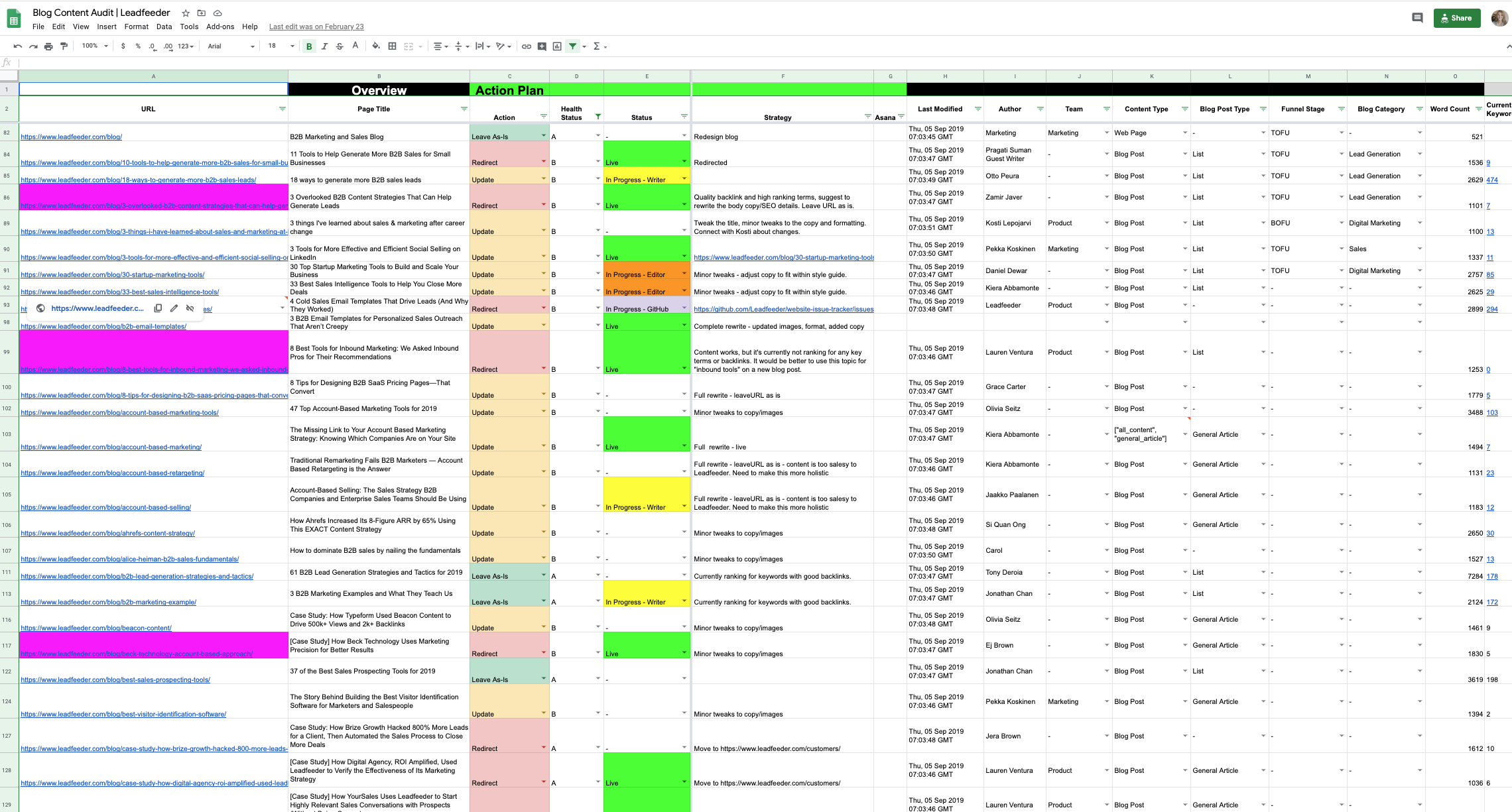
In less than 8 months, I managed to double organic traffic and increase conversions by 20% by improving their existing blog posts.
If a page doesn’t align with user intent, it may perform well for a short time, but eventually, Google will catch on.
Create a Framework for Existing Pages
Whether you’re doing all the work yourself or working with a large team, set standards for your content updates.
It’s the best way to streamline the process and make sure you’re following best practices.
Their content framework included a target word count, UX tactics, and guidelines on how to push lead magnets and calls-to-action more effectively.
Optimizing for Intent for New Pages
Moving forward, here’s how you can use intent more effectively:
- Include user intent as part of your content plan and creative briefs. Writers are often given a set of keywords and told to “go.” Everyone involved in content creation should be talking about intent, not just SEO pros. The person who develops the copy needs to have a clear understanding of the question they’re answering with the content they write.
- Talk about intent before you determine the content type. This means that SEO needs a seat at the table before decisions are made on content. Otherwise, you end up with a blog about accounting software pricing when what you need is a landing page.
- Use intent to maneuver leads down the funnel. In fact, let’s address that in more detail in its own section.
Target Keywords Related to Buying Journey Pain Points
Even an intent-focused SEO strategy can fall short.
How?
Because your audience’s needs are increasingly nuanced.
B2B buyers spend 27% of their time researching online before making a purchase.
And the buying journey is more like what my teeth looked like in 6th grade, crooked, rather than a straight, braces-enhanced, path down the funnel.
All that online research can’t easily fit into either “transactional” or “informational” boxes.
You can help guide your users through the process with content that helps them navigate that maze.
This is the pain point-first approach that Growth and Convert advocates.
For one client, they found that the highest conversions came from pages that addressed pain points in the buying process.
For example, pages like this are high converting because they address a pain point by comparing products.
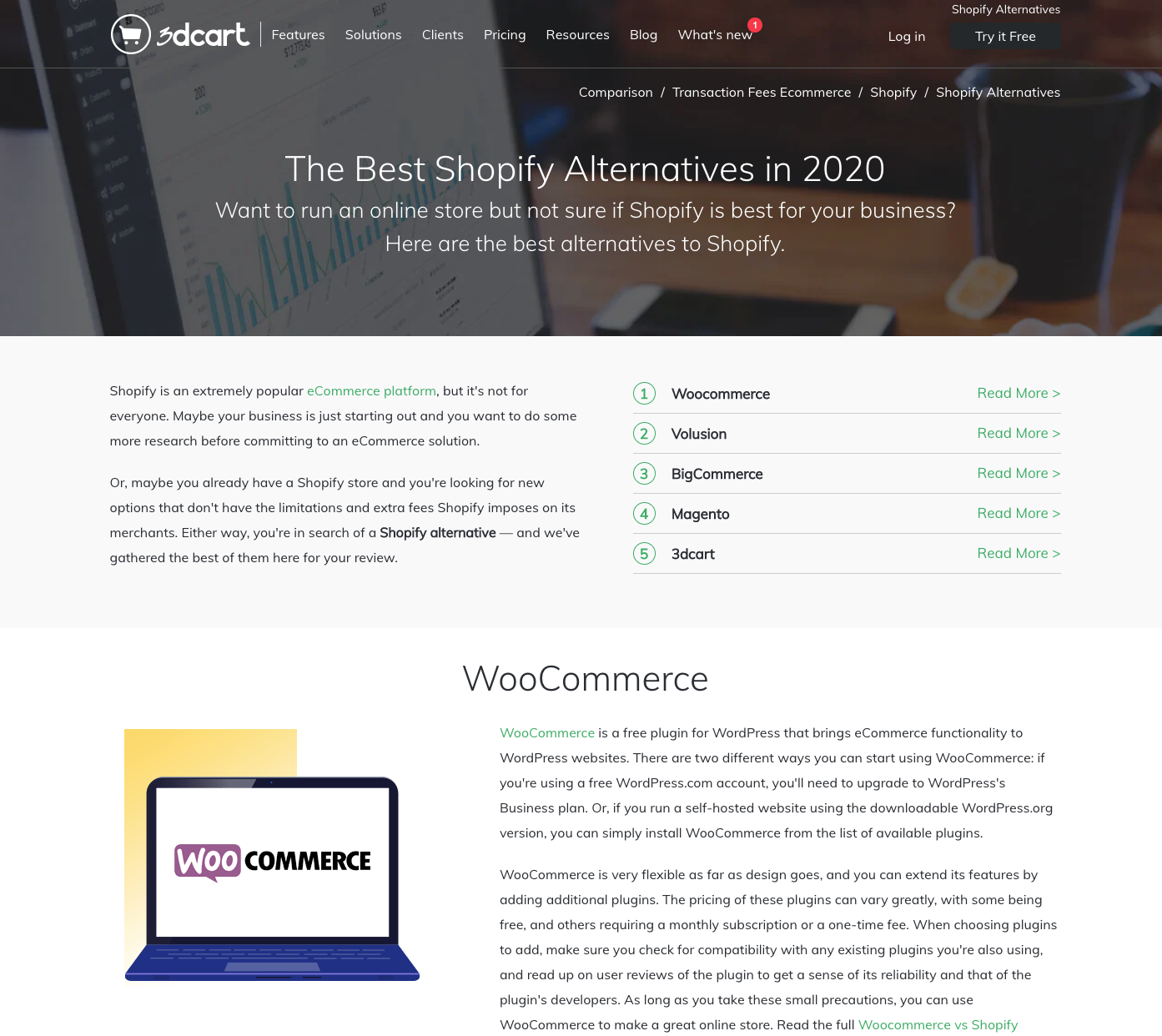
The pages that targeted high-volume search terms drew in users but converted at much lower levels.
Moral of the story: Include content that speaks to your audience’s questions about the buying process itself.
Dig deeper into search queries to learn what your audience wants at different stages of the funnel.
Leads who want buyer’s guides, comparisons, product reviews, etc. may not be ready to buy today, but they may be ready to become a qualified lead.
2. Optimize for Branded Search Terms
Targeting branded search terms is another way to grab leads that are lower in the funnel.
When someone searches for “[your company] ebooks” or “[your company] webinars,” that’s a high-value lead that you want to satisfy. They’re aware of your brand and they’re asking for more.
Optimized pages that meet their needs are low-hanging fruit.
This is one of the tactics Gaetano DiNardi used to help drive a 400% increase in growth at Sales Hacker.
He found that there was search volume for “Sales Hacker webinar,” but no pages on their site where someone could easily find their webinars.
The solution was a quick fix: a landing page that contained all of Sales Hacker’s webinar content.
The search volume on branded terms may be low, but these are valuable leads who are requesting your content by name.
Serving them the content they want pays off.
3. Nurture, Nurture, Nurture
Everyone who visits your site isn’t ready to convert right away.
It’s not you, I promise.
They’re just not ready for anything serious. But they’re open to a little content here and there. It’s like a coffee date with no commitment.
Lead nurturing – the process of engaging with leads across channels over a period of time – is an art and science in and of itself.
Since email is the primary, and most effective, channel for lead nurturing, I’ll focus on that in this section.
Segmentation
51% of email marketers say email list segmentation is the most effective way to personalize lead nurturing.
Automation tools like Active Campaign and MailChimp make it pretty easy to create audience segments.
What are they based on? Any data you have:
- Pages visited
- Form capture data – title, industry, purchase cycle, etc.
- Cart abandonment
- Location
For instance, I’ve set-up automation nurture campaigns in Active Campaign after someone visits a product page, then an email is triggered to send them with a case study to help drive them further down the funnel.
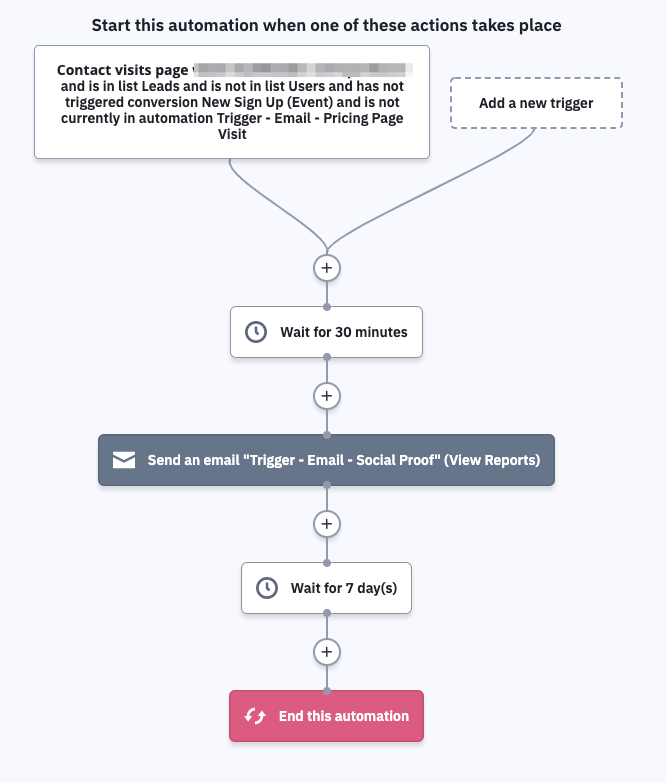
Segmentation is the gateway to personalization.
And with inboxes flooded with content, tailoring your message helps you break through the noise.
Content
What should your message be?
Since these leads aren’t quite ready to buy, you should continue to offer useful, non-salesy content to endear them to your brand.
Anne Fairfield-Sonn of CiBO Technologies told Databox:
“Marketers should be creating and targeting leads with persona specific content. When a lead comes through, figure out what piece of content resonated with them and make sure to move them into that sales funnel. Understanding the content that appeals to your ideal audience is critical to helping your sales team to close the deal more quickly.”
Develop a cadence that balances promotion with education. You want to be a helpful, unobtrusive resource to your audience.
They signed up for content that helps them be smarter, better, or faster.
Offer that before getting to the sales pitch.
4. Make Double Opt-Ins Super Simple
Double opt-ins help keep your email database free of bots and bad actors.
The danger is in the possibility that users won’t bother to confirm their subscription.
I Will Teach You To Be Rich added a three-step graphic to their double confirmation page to nudge subscribers along.
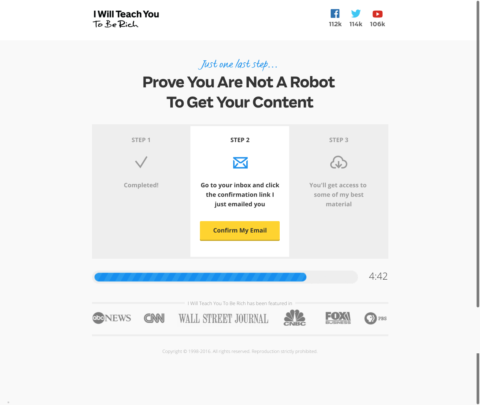
The prominent CTA button goes to the user’s inbox and pulls up a search for the email address sending the confirmation email.
This version of the page gets an 82% conversion rate, up from 63%.
Every lead went through that page, so the nearly 20% increase had a major impact on their lead total.
5. Promote Your Content Upgrades
Ideally, the leads you attract with organic traffic will be drawn to your content upgrades.
But that depends on you communicating the value of those upgrades effectively.
Sleeknote was able to increase conversions by 177.78% on one of their blog posts by taking a few measures:
- Making the blog introduction more enticing.
- Moving lead forms higher up on the page.
- Adding images and pithy copy to content call-out-boxes.
Once someone’s on the page, you’ve got to sell them on a reason to stay. And then give them a reason to stay engaged before they leave.
With all the attention that goes to page copy itself, content upgrades can be an afterthought. To drive lead generation, it should become more of a priority.
Conclusion
Organic leads are valuable.
The challenge is that SEO can cast a wide net.
That’s why it’s important to remember that you don’t just need to optimize your content for Google; you need to optimize it for conversion.
More Resources:
- How Can I Get My Website Traffic to Convert?
- 101 Tips & Tricks That Will Boost Your Conversion Rates
- What Is the Best Way to Track Organic Conversions?
Image Credits
Featured Image: Created by author, June 2020
All screenshots taken by author, June 2020

